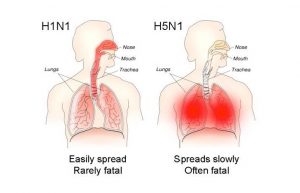Bird Flu:

Fresh cases of bird flu have been confirmed in the Kuttanad region of Kerala. Response teams have been formed for culling birds in affected areas.
- Samples have tested positive for the H5N1 influenza virus.
- Bird flu also called avian influenza.
- It is a disease caused by avian influenza Type A viruses found naturally in wild birds worldwide.
- Symptoms have ranged from mild to severe influenza-like illness.
- Avian Influenza type A viruses are classified based on two proteins on their surfaces – Hemagglutinin(HA) and Neuraminidase(NA).
- There are about 18 HA subtypes and 11 NA subtypes.
- Several combinations of these two proteins are possible e.g., H5N1, H7N2, H9N6, H17N10, etc.
- There have been reports of avian and swine influenza infections in humans.
- The infection is deadly as it has a high mortality rate of about 60%.
- The most common route of virus transmission is direct contact. They can also be affected if they come in contact with contaminated surfaces or air near the infected poultry.
- There are no known cases of H5N8 in human beings. Risk to general public is very low.
- There is also no evidence that consumption of poultry meat or eggs could transmit the virus to humans. But necessary precautions are required while handling sick/dead birds and contaminated material during control and containment operations. It is considered safe to eat properly cooked poultry products.
- Culling is usually undertaken to control the infection when it is detected in animals.
- Besides culling, safe disposal of all such culled animals and animal products is also important.
- The authorities also need to strictly enforce decontamination of infected premises and undertake quarantine of contaminated vehicles and personnel.




